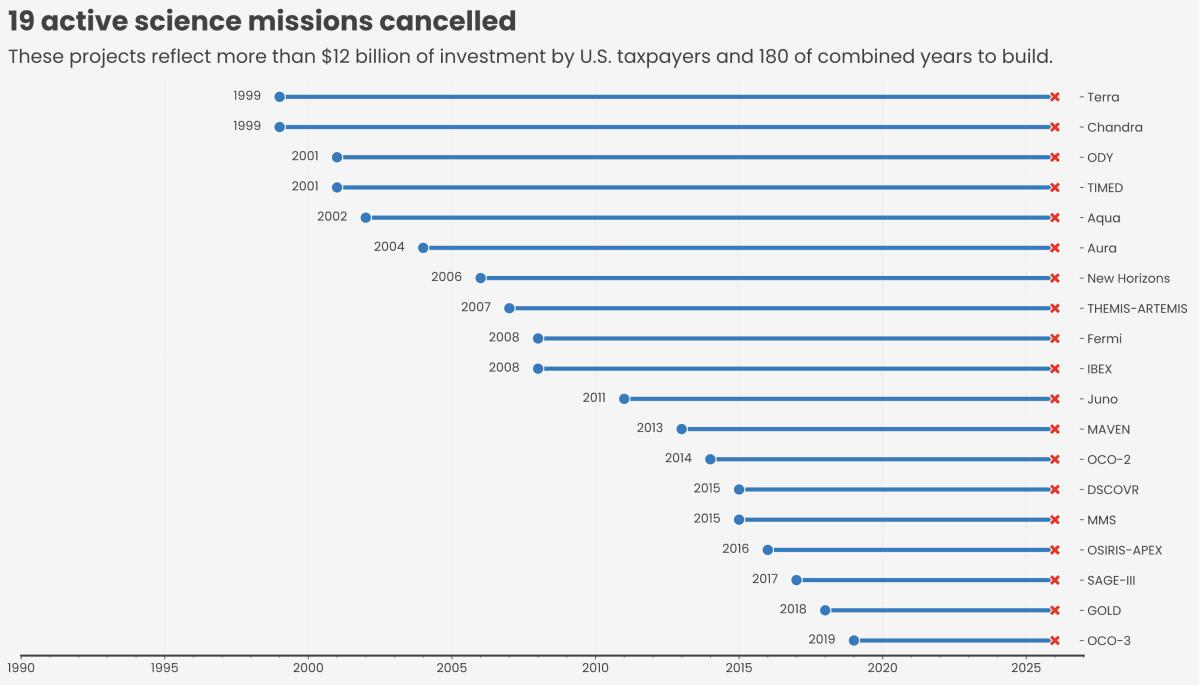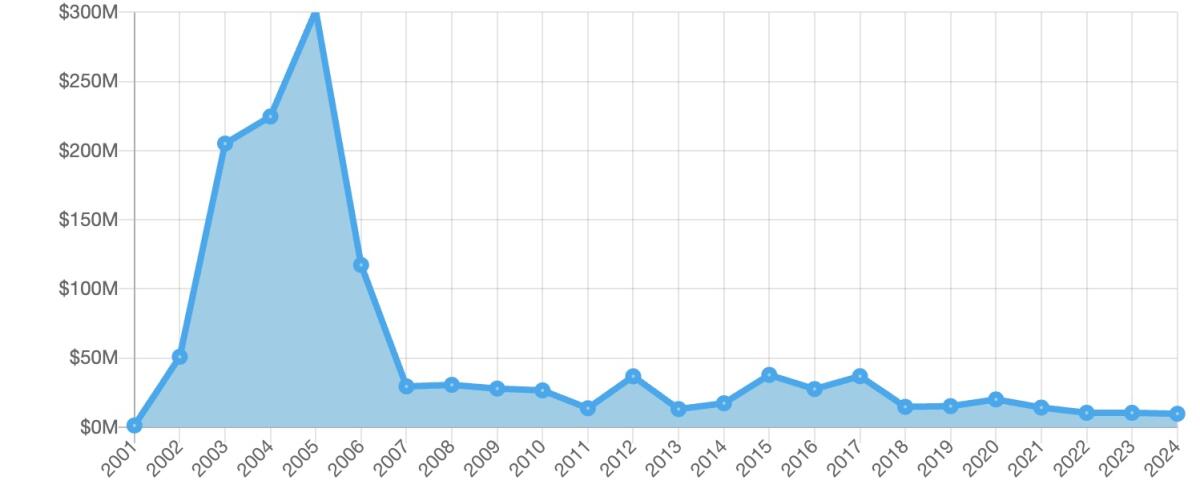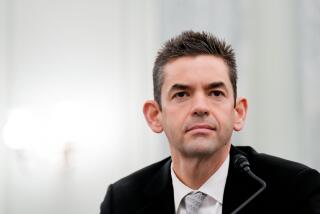Trump’s NASA cuts would destroy decades of science and wipe out its future

- Share via
Like all sponsors of science programs, NASA has had its ups and downs. What makes it unique is that its achievements and failures almost always happen in public.
Triumphs like the moon landings and the deep-space images from the Hubble and Webb space telescopes were great popular successes; the string of exploding rockets in its early days and the shuttle explosions cast lasting shadows over its work.
But the agency may never have had to confront a challenge like the one it faces now: a Trump administration budget plan that would cut funding for NASA’s science programs by nearly 50% and its overall spending by about 24%.
This is us metaphorically closing our eyes.
— Casey Dreier, Planetary Society, on proposed NASA budget cuts
The budget, according to insiders, was prepared without significant input from NASA itself. That’s not surprising, because the agency doesn’t have a formal leader.
On May 31 Donald Trump abruptly pulled the nomination as NASA administrator of Jared Isaacman, a billionaire entrepreneur, space enthusiast, and two-time crew member on private space flights, apparently because of his ties to Elon Musk. The withdrawal came only days before a Senate confirmation vote on Isaacman’s appointment.
Get the latest from Michael Hiltzik
Commentary on economics and more from a Pulitzer Prize winner.
You may occasionally receive promotional content from the Los Angeles Times.
While awaiting a new nominee, “NASA will continue to have unempowered leadership, not have a seat at the table for its own destiny and not be able to effectively fight for itself in this administration,” says Casey Dreier, chief of space policy at the Planetary Society, a leading research advocacy organization.
Things haven’t been helped by the sudden breakup between Trump and Musk, whose SpaceX is a major contractor for NASA and the Department of Defense, the relationship with which is now in doubt.
The cuts, Dreier says, reduce NASA’s budget to less than it has been, accounting for inflation, since the earliest days of Project Mercury in the early 1960s.
Superficially, the budget cuts place heightened emphasis on “practical, quantitative,” even commercial applications, Dreier told me. Programs transmitting weather data from satellites, valued by farmers, remain funded, but studies of climate change and other studies of Earth science are slashed. Astrophysics and other aspects of space exploration also are eviscerated, with 19 projects that are already operating destined for cancellation.
(The Hubble and Webb space telescopes, which thrill the world with the quality and drama of their transmitted images, are spared significant cuts.)
The budget cuts will undermine the administration’s professed goals. That’s because many of the scientific projects on the chopping block provide knowledge needed to advance those goals.
Donald Trump has always posed as someone smarter than scientists. Does that explain why so much of his dismantling of the federal government is aimed at scientific agencies?
The proposed budget does include two longer-term scientific goals endorsed by Trump — a return of astronauts to the moon via a project dubbed Artemis, and the landing of a crew on Mars.
The highly ambitious Artemis timeline anticipates a crewed landing in late 2027 or early 2028. As for the Mars landing, that goal faces so many unsolved technical obstacles that it has no practical timeline at this moment. (Doubts about its future may have deepened due to the sudden rift between Trump and the Mars project’s leading advocate, Elon Musk.)
The administration’s approach to NASA involves a weirdly jingoistic notion of the primacy of American science, akin to the administration’s description of its chaotic tariff policies.
Trump has said he wants the U.S. to dominate space: “America will always be the first in space,” he said during his first term. “We don’t want China and Russia and other countries leading us. We’ve always led.”
Vice President JD Vance recently told an interviewer on Newsmax that “the American Space Program, the first program to put a human being on the surface of the moon, was built by American citizens. ... This idea that American citizens don’t have the talent to do great things, that you have to import a foreign class of servants, I just reject that.”
Among the “foreign class of servants,” whom Vance acknowledged included “some German and Jewish scientists” who came to the U.S. after World War II, was the single most important figure in the space program — Wernher von Braun, a German engineer who had helped the Nazis develop the V-2 rocket bomb (using Jewish slave labor) and who was recruited by the U.S. military after the war. The lunar rover that allowed astronauts to traverse the moon’s surface was developed by the Polish-born Mieczyslaw G. Bekker and Ferenc Pavlics, a Hungarian.
Elon Musk thinks humankind’s only safety valve is to move multitudes to Mars. He has no idea how foolhardy and dangerous that would be.
The human exploration of space, its advocates say, could cement America’s relationship with its scientific allies. No mission on the scale of a return to the moon or a manned voyage to Mars could conceivably be brought off by the U.S. acting alone, much less by a Republican administration alone or within the time frame of practical politics. These are long-term projects that require funding and scientific know-how on a global scale.
Because of the relationship between the Martian and Earth orbits, for instance, Mars launches can only be scheduled for two-month windows every 26 months. That necessitates building partisan and international consensuses, which appear elusive in Trumpworld, in order to keep the project alive through changes in political control of the White House and Congress.
“Celestial mechanics and engineering difficulties don’t work within convenient electoral cycles,” Dreier observes. In this White House, however, “there’s no awareness that the future will exist beyond this presidency.”
A representative of the White House did not respond to a request for comment.

Trump’s assault on NASA science and especially on NASA Earth science is nothing new. Republicans have consistently tried to block NASA research on global warming.
In 1999, the Clinton administration fought against a $1-billion cut in the agency’s Earth science budget pushed by the House GOP majority. (Congress eventually rejected the cut.) During the first Trump term, the pressure on Earth science came from the White House, while Trump dismissed global warming as a “hoax.” He wasn’t very successful — during his term, NASA’s budget rose by about 17%.
Characteristically for this administration, the proposed cuts make little sense even on their own terms. Programs that superficially appear to be pure science but that provide data crucial for planning the missions to the moon and Mars are being terminated.
This week’s award of the Nobel Prize in physics to Peter Higgs of the University of Edinburgh and Francois Englert of the Free University of Brussels is a reminder of how the U.S. blew the chance to confirm their theory of the “Higgs boson.”
Among them is Mars Odyssey, a satellite that reached its orbit around the red planet in late 2001 and has continued to map the surface and send back information about atmospheric conditions — knowledge indispensable for safe landings. The Mars Atmosphere and Volatile Evolution mission, which reached Mars orbit in 2014, has provided critical data about its upper atmosphere for 10 years.
In fiscal terms, the budget cuts are penny-wise and galactically foolish. The costs of space exploration missions are hugely front-loaded, with as much as 90% or 95% consumed in planning, spacecraft design and engineering and launch.
Once the crafts have reached their destinations and start transmitting data, their operational costs are minimal. The New Horizons spacecraft, launched in 2006 to explore the outer limits of the Solar System (it reached Pluto in 2016 and is currently exploring other distant features of the system), cost $781 million for development, launch, and the first years of operation. Keeping it running today by receiving its transmitted data and making sure it remains on course costs about $14.7 million a year, or less than 2% of its total price tag.

Terminating these projects now, therefore, means squandering billions of dollars in sunk costs already borne by taxpayers. Exploratory spacecraft can take 10 years or more to develop and require the assemblage of teams of trained engineers, designers, and other professionals.
Then there’s the lost opportunity to nurture new generations of scientists. The proposed budget shatters the assumption that those who devote 10 or 15 years to their science education will have opportunities awaiting them at the far end to exploit and expand upon what they’ve learned.
Sean Kirkpatrick ran the government’s investigation into UFOs, so he knows a lot about how misinformation and disinformation become grist for Congress and an unthinking news media
The deepest mystery about the proposed budget cuts is who drafted them. Circumstantial evidence points to Russell Vought, director of the White House Office of Management and Budget and the main author of Project 2025, the infamous right-wing blueprint for the Trump administration.
NASA doesn’t appear in Project 2025 at all. It does, however, appear in a purportedly anti-woke 2022 budget proposal Vought published through his right-wing think tank, the Center for Renewing America. In that document, he called for a 50% cut in NASA’s science programs, especially what Vought called its “misguided ... Global Climate Change programs,” and a more than 15% cut in the overall NASA budget.
The 47% cut in science programs and 24% overall is “very suspiciously close to what Vought said he would do” in 2022, Dreier says. I asked the White House to comment on Vought’s apparent fingerprints on the NASA budget plan, but received no reply.
The abrupt termination of Isaacman’s candidacy for NASA administrator is just another blow to the agency’s prospects for survival. The space community, which saw Isaacman as a political moderate committed to NASA’s institutional goals, was cautiously optimistic about his nomination.
“Someone who had the perceived endorsement of the president and the power to execute, would be in a position if not to change the budget numbers themselves, but to take a smart, studied and effective route to figure out how to make the agency work better with less money,” Dreier told me. That may have been wishful thinking, he acknowledged. No replacement has yet been nominated, but “I don’t think anyone is thinking this is going to be a better outcome for the space agency, whoever Trump nominates,” Dreier says.
The consequences of all this amount to an existential crisis for NASA and American space science. They may never recover from the shock. The void will be filled by others, such as China, which could hardly be Trump’s dream.
At the end of our conversation, I asked Dreier what will become of the 19 satellites and space telescopes that would be orphaned by the proposed budget.
“You turn off the lights and they just tumble into the blackness of space,” he told me. “It’s easy to lose a spacecraft. That’s the weird, symbolic aspect of this. They’re our eyes to the cosmos. This is us metaphorically closing our eyes.”
More to Read
Insights
L.A. Times Insights delivers AI-generated analysis on Voices content to offer all points of view. Insights does not appear on any news articles.
Viewpoint
Perspectives
The following AI-generated content is powered by Perplexity. The Los Angeles Times editorial staff does not create or edit the content.
Ideas expressed in the piece
- The proposed budget cuts would reduce NASA’s science funding by nearly 50%, threatening 19 active missions like Mars Odyssey and the Mars Atmosphere and Volatile Evolution program, which provide critical data for future exploration.
- Climate change research and Earth science programs face severe reductions, while weather satellite initiatives deemed “practical” for agriculture remain funded, reflecting a prioritization of short-term commercial interests over long-term scientific inquiry[2].
- The administration’s emphasis on American-led human spaceflight goals (Artemis and Mars missions) clashes with the technical and collaborative realities of space exploration, as international partnerships and bipartisan support are essential for sustaining multi-decade projects.
- Terminating operational missions like Mars Odyssey squanders billions in sunk costs, as these projects require minimal ongoing funding compared to their initial development expenses.
- Leadership vacuums at NASA, exacerbated by the withdrawal of Jared Isaacman’s nomination and tensions with Elon Musk’s SpaceX, weaken the agency’s ability to advocate for itself or adapt to reduced funding[3].
Different views on the topic
- The budget aims to streamline NASA’s focus by ending 40 “lower priority” science missions, redirecting resources toward the Commercial Moon to Mars Infrastructure and Transportation Program to leverage private-sector innovation for cost efficiency[1][2].
- Human space exploration receives a $647 million boost, aligning with the administration’s goal of revitalizing crewed missions to the Moon and Mars as symbols of American technological dominance[3][1].
- Critics argue that reducing Earth science funding targets climate change research, which the administration has historically dismissed as a “hoax,” while preserving weather data programs that directly benefit industries like agriculture[3].
- Proponents suggest shifting responsibility for routine space activities to commercial entities, such as SpaceX, could free NASA to concentrate on groundbreaking exploration efforts, though this relies on stable public-private partnerships[1].
- The budget’s architect, Russell Vought, has previously advocated for defunding NASA’s “misguided” climate programs, framing the cuts as part of a broader effort to deprioritize federal spending on environmental research[1].
Get the latest from Michael Hiltzik
Commentary on economics and more from a Pulitzer Prize winner.
You may occasionally receive promotional content from the Los Angeles Times.














